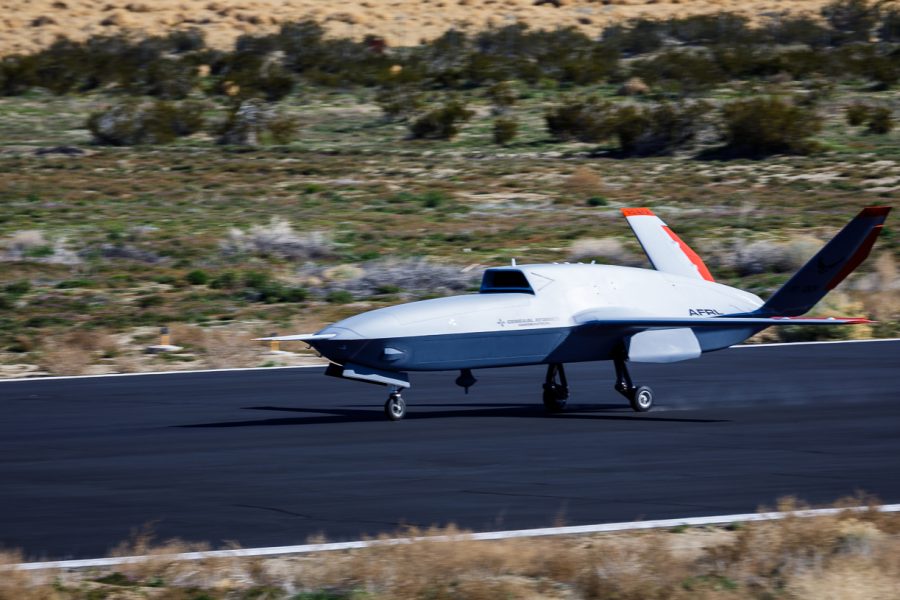Though the Air Force plans to buy as many as 2,000 Collaborative Combat Aircraft through the late 2030s, only about 100 will be built by 2029, Secretary Frank Kendall told lawmakers April 30. After an initial award last week, more CCA contracts will follow on a roughly two-year tempo, he said.
During a House Appropriations defense subcommittee hearing, Kendall was asked how many CCAs will be in service and how soon.
“We’ll have over 100 on order or delivered by the end of the [Future Years Defense Program]; that’s for Increment 1,” Kendall said. The FYDP covers the next five years, ending in fiscal 2029.
Kendall noted that he has provided a “planning figure” of 1,000 CCAs. “That’s just really to reflect the fact that we’re serious about this, it’s going to be a significant part of our force structure,” he said.
The Air Force announced Anduril and General Atomics as the finalists for the first increment of CCAs on April 24. The two companies beat out aircraft primes Boeing, Lockheed Martin, and Northrop Grumman for the award, but the service said those companies can compete for the second increment on their own dime. The Air Force has declined to disclose details of the Increment 1 contracts, including their dollar value.
Kendall has said up to 2,000 CCAs might be in the Air Force’s long-term plans. But he told lawmakers that the “ultimate number is going to depend upon all the costs, portability [of technology to and from other platforms] and a number of other factors.”
Regardless, Kendall called CCAs a “fairly transformative change to going away from the individual fighter pilots all out there at risk together, to giving our fighter pilots a wingman.
“It can be attrited to a degree—it’s intended to be survivable—but attritable,” he added, meaning the drones can be lost in acceptable numbers. “That will give us a wide range of tactics and techniques that we currently can’t utilize.”
Asked how many CCAs will be acquired for every crewed fighter, Kendall said two to five is a likely range, but that “we won’t do it for every single fighter, probably, at least not initially.”
Kendall’s desired cost of a CCA will top out at about $25 to $30 million, he said; a “fraction” of the price of a crewed fighter. That would be about a third of the cost of an F-35, which came in at about $80 million each under the most recently-negotiated lot.
Air Force officials have said a contract for Increment 2 is expected to be awarded in 2025 or 2026, but that platform has not yet been defined. Service officials said it started out as being an “exquisite,” high-end, stealthy platform, but the service went back to the drawing board after wargames showed that large numbers of low-end CCAs were more valuable in a Pacific conflict than small numbers of high-end versions.
“The way the program is structured, it has multiple increments; they’re about two years apart,” Kendall explained in the hearing. Increment 1 is meant to go “quickly to production,” he said.
“We expect to have those aircraft in production within a few years and have deliveries before the end of the five-year plan,” he said.
Those first aircraft will “allow us to learn a lot; they’ll give us an operational capability,” Kendall said. “There’ll be a second increment coming along a couple of years behind that one. And we are particularly looking for international cooperation with that second increment.”
Boeing developed its MQ-28 Ghost Bat—also called the Airpower Teaming System—with Australia, and the Air Force has shown interest in that modular, uncrewed aircraft. The U.K. and other international partners are also working on their own autonomous aircraft. Kendall said he and Chief of Staff Gen. David W. Allvin have discussed cooperation with several allies.
Pentagon acquisition and sustainment chief William LaPlante has noted that producing the same platforms or munitions in multiple countries would enhance coalition surge capability and interoperability, and provide a powerful deterrent if such items were produced at scale.
The “secret sauce” that will “enable us to be more rapidly integrating with our allies and partners” is the fact that the CCA will generate a “government-owned reference architecture that we control,” said Allvin at the hearing.
“And so, as we are seeing advancements in the technology, we can maybe set the pace for how we can integrate and work with our allies and partners.”
